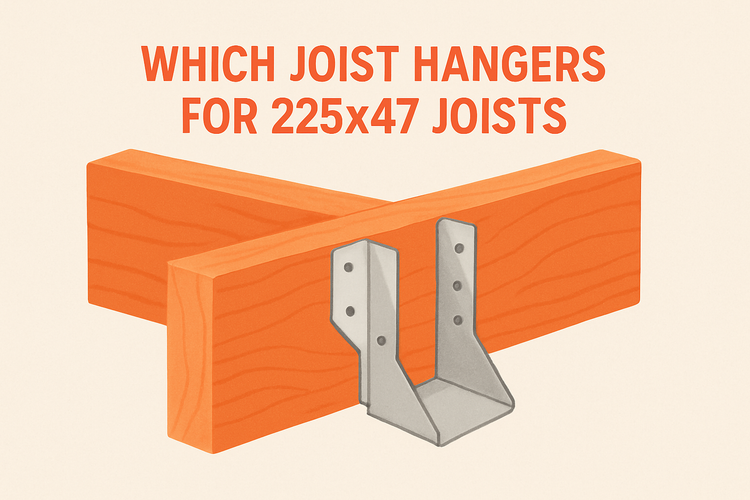Which Joist Hangers For 225x47 Joists

Choosing the Correct Joist Hanger for 225x47 Joists
When working with 225x47 timber joists, selecting the appropriate joist hanger ensures structural integrity and long-term performance. Not all joist hangers are made alike, so matching the exact size and load-bearing needs is crucial.
The ideal joist hanger for a 225x47 joist is one that accommodates a 47mm width snugly while supporting the depth of 225mm. Heavy-duty versions, such as face fix or masonry return types, are often required for such large-sized joists depending on the application. [Joist Hangers](https://jandeconstruction.co.uk/collections/joist-hangers) designed for deeper structural timber support often include longer wraparound flanges and reinforced fixings to hold substantial loads. Always ensure the chosen hanger is EN-standard approved for safety and reliability.
Face Fix vs Concealed Joist Hangers for Timber Installations
For 225x47 timber joists, choosing between face fix and concealed joist hangers plays a key role in both the appearance and functionality of your structure. Face fix options are visible but easy to install, while concealed options are ideal for clean finishes and tighter joinery.
Face fix hangers are a popular choice due to their straightforward installation process. They require simple nail or screw attachment on the face of the structural timber and provide a robust and visible joint. The ease of visual inspection and the strength of the face fixers make them suitable for heavy-duty joist spans, such as decks, flooring systems or loft conversions using large-sized timbers like 225x47.
On the other hand, concealed hangers offer an aesthetically superior finish, often used in timber frame interiors or visible roof constructions where exposed hardware is unwanted. These hangers are recessed into a pocket cut into the timber end, helping maintain clean lines and a polished appearance. Concealed joist hangers offer a high load-bearing capacity but require more precise woodworking tools and skills during installation, especially when dealing with heavier joists.
Installing Joist Hangers for Structural Stability
Proper installation is just as essential as choosing the right joist hanger. Poorly fitted hangers can lead to sagging joists, creaking floors, or even structural failures over time.
Secure installation of joist hangers includes selecting compatible screws or nails. Always use hangers and fasteners supplied or recommended by the hanger manufacturer, as these are tested for maximum performance. [Screws and Nails](https://jandeconstruction.co.uk/collections/screws-nails) engineered for joist hangers often feature serrated or ribbed textures to improve withdrawal resistance and ensure a secure fit. Additionally, pre-drilling may be required around tighter edge distances to avoid timber splits.
Alignment during installation is vital: the joist must sit flush in the hanger without gaps. The sides of the hanger should encapsulate the joist fully, with no room for lateral movement. Use a framing square to verify straightness across the joist alignment, especially in multi-joist setups like decking substructures or flooring trusses. A consistent level ensures equal distribution of loads and extends the life of the structure.
Supported Construction Elements for 225x47 Joists
Understanding what structures benefit from the use of 225x47 joists can help determine proper support and required fixing hardware. These large timbers are prevalent in residential framing, flooring joists, roof rafters, and decking applications.
In roof construction, joist hangers are often paired with [Roof Connectors](https://jandeconstruction.co.uk/collections/roof-connectors) for a dependable integration with rafters and purlins. Depending on load transfer direction, perimeter timber members at the top wall may also require [Restraint Straps](https://jandeconstruction.co.uk/collections/restraint-straps) to hold lateral forces in check. Using compatible connectors ensures the full structural network works in cohesion, reducing risk of twisting, warping, or shearing forces due to environmental load or structural shifts over time.
Moreover, integrating 225x47 joists into decks or raised platforms might entail additional use of [Post Bases](https://jandeconstruction.co.uk/collections/post-base) to secure vertical structural posts. When spanning longer distances or bearing heavier decking boards or load zones, spacing and anchoring become paramount to avoiding overstress or creeping deflection. Accurately installed support accessories complement joist hangers, creating a load-path resistant to deterioration and dislocation.
Maintaining the Integrity of Joist Hanger Systems
Once the joist hanger system has been installed, long-term durability depends on regular inspection, moisture control, and avoiding excessive structural loads. Timber joints, especially in exterior installations, can degrade quicker when support hardware corrodes or loses tension.
Many premium [Joist Hangers](https://jandeconstruction.co.uk/collections/joist-hangers) are galvanised to resist rust in outdoor environments. However, routine inspection after storm seasons or freeze-thaw cycles helps detect damage early. Look for signs of joist sagging, wood rot near hardware contact points, or stripped screws. Replacing compromised hangers or reinserting fixings at identified stress zones prevents cascading structural failures.
Moisture barriers and compatible timber treatments also contribute to system longevity. While the timber might be pressure-treated, metal hangers should always be specified to match treatment corrosivity levels. Combining these elements with weather-fit [Post Bases](https://jandeconstruction.co.uk/collections/post-base) or re-tightening straps and fixings every few seasons promotes the continued performance of load-bearing assemblies.
